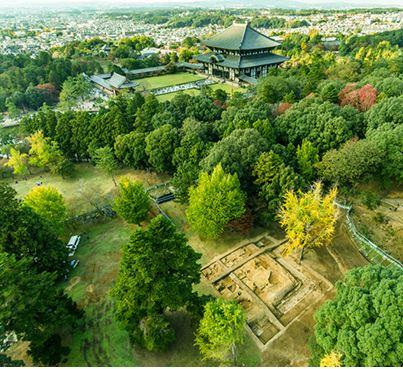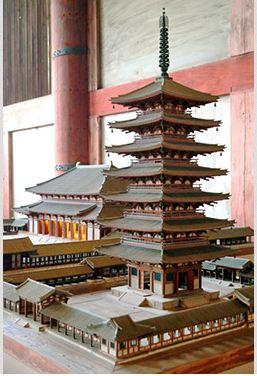Yumi Kurita
Source -http://ajw.asahi.com/article/behind_news/social_affairs/AJ201512090007?
A Todaiji temple pagoda razed in war during the Heian Period (794-1185) was likely rebuilt into one of the biggest structures of its kind in Japan using state-of-the-art technology from China, archaeologists said.
 The site of Toto (east pagoda) at Todaiji temple in Nara, with the Great Buddha Hall visible in the background (Photo by the Nara National Research Institute for Cultural Properties and Yamaha Motor Co.; provided by Todaiji)
The site of Toto (east pagoda) at Todaiji temple in Nara, with the Great Buddha Hall visible in the background (Photo by the Nara National Research Institute for Cultural Properties and Yamaha Motor Co.; provided by Todaiji)
The rebuilt Toto (east pagoda) at the famed temple in the ancient capital burned down again after it was hit by lightning in 1362.
Officials of Todaiji temple, which is conducting an excavation study at the Toto site, said Nov. 19 that the rebuilding process in the Kamakura Period (1192-1333) created a structure somewhat larger than the original and probably had dimensions unparalleled in Japan. The pagoda may have towered 100 meters.
“It was accepted practice in Nara to restore temples after how they looked during the Tenpyo Era (729-749), but the latest finding has uncovered an exception for the first time,” said Kakichi Suzuki, leader of the study group and a former director of the Nara National Cultural Properties Research Institute.
“Perhaps people at the time decided to follow the style of the Song Dynasty (960-1279) of China and build a solid pagoda with thicker pillars, just as they did with the Great Buddha Hall and the Great South Gate of Todaiji,” Suzuki said.
The Toto plot is a “historic site” designated by the central government.
A pair of pagodas, Toto and Saito (west pagoda), were built around the 750s or 760s to the southeast and southwest, respectively, of the Great Buddha Hall of Todaiji.
Toto was set on fire by the Taira warrior clan in 1180 and rebuilt in 1227. Saito was lost to a lightning strike in 934 and not rebuilt.
The temple’s excavation study of the Toto site is being conducted jointly with the Nara National Research Institute for Cultural Properties and the Archaeological Institute of Kashihara of the Nara prefectural government.
The researchers have unearthed pillar cornerstone holes, staircases, cobblestones and other artifacts.
 A miniature of Toto is on display in the Great Buddha Hall of Todaiji temple in Nara. (Gen Hashimoto)
A miniature of Toto is on display in the Great Buddha Hall of Todaiji temple in Nara. (Gen Hashimoto)
The structure’s foundation, which is believed to date from the Kamakura Period, was about 27 meters wide per side. Each of the pagoda’s north, south, east and west faces had a three-span structure. The area on which the building stood was about 17 meters wide per side.
The excavation study has also unearthed stones that likely constituted peripheral parts of a staircase when the pagoda was initially built. The original foundation was apparently 24 meters wide per side.
The 55-meter five-story pagoda at Toji temple in Kyoto is the tallest of all existing pagodas in Japan.
There are two disagreeing records of the height of the Toto and Saito pagodas of Todaiji, with one saying some 70 meters, and the other some 100 meters.
The two central pillars on each side were about 6 meters apart, while space between the corner pillars and first inner pillars was about 5.4 meters. These were around the same dimensions used in the Great South Gate.
The building structure was apparently supported by pillars that were thicker than those commonly used in the Nara Period (710-794). It was reinforced by horizontal beams called “nuki” (penetrating tie beams) that passed through the pillars, the experts said.
Investigations next year will begin into remnants from the time the pagoda was initially built during the Nara Period. Preservation of the pagoda foundation will start in 2021.
Studies of the remains of Saito are expected to begin in 2017.